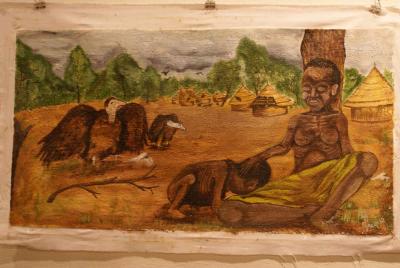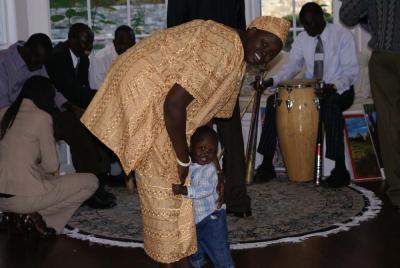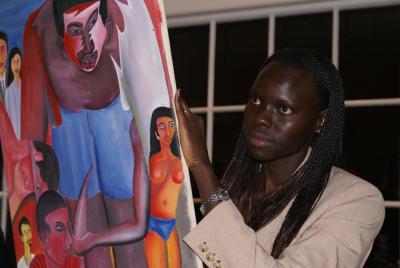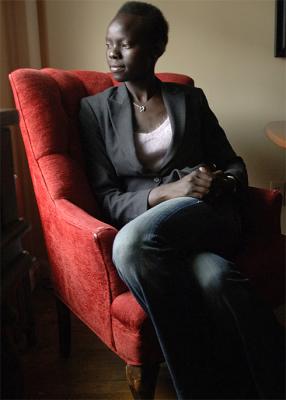Thursday, 2. August 2007
Aduei in USA Today
ieva jusionyte, 07:56h
... link (0 Kommentare) ... comment
Monday, 15. January 2007
The Globe on Sudan
´The Boston Globe´ on our class project with the southern Sudanese diaspora:
http://www.boston.com/news/local/articles/2007/01/11/lost_and_found/?page=1
http://www.boston.com/news/local/articles/2007/01/11/lost_and_found/?page=1
ieva jusionyte, 09:47h
... link (2 Kommentare) ... comment
Sunday, 24. December 2006
reflections on refugee art exhibition
To bring a cultural artifact to a memorial place it must first and foremost be classified as past, it must be situated in a specific niche of public memory, it should even be based on written history that kids can be taught at school. In this fashion not only brilliant inventions of mankind have been arranged in an evolutionary sequence behind the display glass, but also human suffering has been remembered only after it was recognized. For the survivors and descendants of such calamities as well as for the civic community museums have served as sanctuaries for the tragic bygone days. Memories of the Jewish Holocaust or the Armenian Genocide have been embodied in great number of monuments that show the world how evil it can be. However, although the peace accords were signed last year, the civil war in South Sudan cannot be labeled as past. It is a living history. Even though talks about opening a museum in Juba have started, the conflict is not over. It remains the menace for the present and many of the artists who created the paintings for the “Leave the Bones and Catch the Land” exhibition are still in Kakuma refugee camp. Nevertheless, Sudan People’s Liberation Army is in favor of opening the museum not only because, by establishing and legitimizing a story of South Sudan as different and autonomous, the fighting would have less ground, but also because the government expects the new Sudan to be built on the memories of the conflict. According to their point of view, civil war stigmatized southern Sudanese and the new state is to be centered on this bloody myth of origin.

In the light of all this arranging an exhibition of refugee paintings has been a quest that required transcending the boundaries between politics and art. A child surrounded by vultures dying from hunger and protected only by the last strength of his mother in the work of Ajok Mayol or a huge dark-skinned refugee immersed in his fantasies about the white people while his leg is being cut in the painting of Stephenal Takiy are not only the colorful lines and shades on canvas that express the creativity and skillfulness of the artists. These pictures are a silent scream of the suffering. They constitute cultural heritage of a displaced people, they embody their living history. Therefore, the paintings could not be equated with traditional utensils of African tribes that museums have been so eager to collect and expose to the public, seeking exotic encounters. The paintings, whether portraying John Garang, Prophet Ngundeng or traditional courting and wedding are political not only due to the content but, most importantly, because the act of their creation itself was determined by decisions made in the realm of politics. And being such they are more than images on canvas; they demand response by action.

Since several years ago the folded canvases reached the U.S. without their authors, nobody but the collective curator, the class doing the project for Dr. M. Auslander’s course on “Museums and Public Memory”, was responsible for making sure that the message of those living in asylum in a refugee camp in northern Kenya is transmitted and understood. But in a situation like this the question had to be asked: how is resonance and wonder reconciled? How is the play between politics and poetics balanced? S. Greenblatt in his contribution to the volume of “Exhibiting Cultures: The Poetics and Politics of Museum Display” recognizes that by giving too much textual context resonance can kill wonder. Then what is the way the context of who, when, where and why of the displaced people could be combined with securing that the artistic character of the paintings remains intact? How is the compelling story of the refugees to be told without losing faith in the viewer who can interpret the work of art on his own? The struggle between educating people by actively raising their awareness of the invisible or unnoticed genocide in South Sudan and leaving art speak for itself expressed the tension of operating in between the domains of politics and art in the process of developing the exhibition.

The class had to decide who the narrator of the story of the refugees from southern Sudan was to be. Authoritative voice of many traditional museums, which were once built in the spirit of Victorian anthropology, seemed to violate the subjectivities of the artists by imposing a static point of view which, because of the power of academic discourse, could claim to be objective. However, as G. Ch. Spivak observes in a groundbreaking essay “Can the Subaltern Speak?”, overcoming this epistemic violence by granting the “voice” to the subalterns in postcolonial discourse, trying to re-establish their collective locus of agency, is also a slippery road that could re-inscribe neo-colonial imperatives on the people whose story is being told. Firstly, it is dangerous because it is only through intellectuals, even if these are students, that the subalterns are allowed to speak. Secondly, such an attempt is based on an assumption of cultural solidarity among the heterogeneous people. The solution was to include multiple voices that, instead of hiding the narrator behind the veil of supposedly objective academic language, can show the complex development of the exhibition as a process. The captions that accompany the paintings in the exhibition as well as the audio tour combine the knowledge students gathered about the Dinka culture and history of civil war with the quotes from interviews with members of the southern Sudanese diaspora community in the U.S. As voices of the students and those of the refugees are polyphonic in the exhibition, the tension between resonance and wonder is diminished.

The project of installing this exhibition manifested the advantages of community engaged learning. Not only did students have an opportunity to learn from the experiences of southern Sudanese, the so-called lost boys and girls of Sudan (who have grown up and this title that attracts attention will have to be changed), spending long afternoons talking about cattle as bride-wealth, dangers awaiting upon entering one’s memories or education and food rationing in Kakuma refugee camp, but they could also contribute to the cause. Cooperation with the community partners, such as Sudanese Education Fund, African Refugee Artists Club and South Sudan Youth Association of Massachusetts, proved that socially aware public anthropology can be of use for the diaspora. Activist research, as opposed to colonial anthropology that served the interests of imperialist administration, which often found itself incapable of managing its newly conquered “savage” subjects, exchanges knowledge for assistance.

Definitely it is art, either in the form of the paintings from Kakuma, jazz collaborations, books of memoirs (“They Poured Fire on Us from the Sky”) or popular documentary movies (“God Grew Tired of Us”), that enabled the creation of the solid ground for cooperation. Art is the open meeting space for all of those who are eager to learn and to engage in conversations. And it is art that will continue the quest of making the collective memories of southern Sudanese public. In their statement of mission the group of African artists taught by Atem Aleu in Kakuma declares that “art connects us to each other through space and time, and lends morale support to those of us still living the lives we express in our paintings”. “Leave the Bones and Catch the Land” is not a fixed museum exhibition. It is mobile and its task is to travel around broadening the ranks of the aware. Discussions of repatriation and cultural property rights in regard to the paintings have not started yet and, probably, they should not start at all. Refugee art belongs to a displaced and stigmatized community, therefore, also to the whole world whose ignorance contributed to their suffering. It has more effect when being abroad than when returning home because Juba is not where the paintings were made. They do not have home. They are nomadic. Just like the people who created them.

An aftermath is a word which doesn’t exist in a project like this. With the opening of the Southern Sudan Cultural Documentation Center at Brandeis the work continues. The war in Sudan can be enflamed any time by the ignorance of the international community to such incidences as happened in Malakal in early December. However, although the goal of showing the story of the refugees through their paintings is of political nature, the quest can only be successful because it is art that speaks for the trauma, transcending the officially recognized boundaries between the realms of power and creativity. Serving both - the dispersed southern Sudanese and the civil society across the continents - the paintings from Kakuma unite memorial and educational objectives. They testify that the story of the refugees is not in the past yet and the struggle to include it into the public memory of the world is still under way.
To see the paintings and more, visit http://www.brandeis.edu/projects/sudan_center/kakuma_exhibit/

In the light of all this arranging an exhibition of refugee paintings has been a quest that required transcending the boundaries between politics and art. A child surrounded by vultures dying from hunger and protected only by the last strength of his mother in the work of Ajok Mayol or a huge dark-skinned refugee immersed in his fantasies about the white people while his leg is being cut in the painting of Stephenal Takiy are not only the colorful lines and shades on canvas that express the creativity and skillfulness of the artists. These pictures are a silent scream of the suffering. They constitute cultural heritage of a displaced people, they embody their living history. Therefore, the paintings could not be equated with traditional utensils of African tribes that museums have been so eager to collect and expose to the public, seeking exotic encounters. The paintings, whether portraying John Garang, Prophet Ngundeng or traditional courting and wedding are political not only due to the content but, most importantly, because the act of their creation itself was determined by decisions made in the realm of politics. And being such they are more than images on canvas; they demand response by action.

Since several years ago the folded canvases reached the U.S. without their authors, nobody but the collective curator, the class doing the project for Dr. M. Auslander’s course on “Museums and Public Memory”, was responsible for making sure that the message of those living in asylum in a refugee camp in northern Kenya is transmitted and understood. But in a situation like this the question had to be asked: how is resonance and wonder reconciled? How is the play between politics and poetics balanced? S. Greenblatt in his contribution to the volume of “Exhibiting Cultures: The Poetics and Politics of Museum Display” recognizes that by giving too much textual context resonance can kill wonder. Then what is the way the context of who, when, where and why of the displaced people could be combined with securing that the artistic character of the paintings remains intact? How is the compelling story of the refugees to be told without losing faith in the viewer who can interpret the work of art on his own? The struggle between educating people by actively raising their awareness of the invisible or unnoticed genocide in South Sudan and leaving art speak for itself expressed the tension of operating in between the domains of politics and art in the process of developing the exhibition.

The class had to decide who the narrator of the story of the refugees from southern Sudan was to be. Authoritative voice of many traditional museums, which were once built in the spirit of Victorian anthropology, seemed to violate the subjectivities of the artists by imposing a static point of view which, because of the power of academic discourse, could claim to be objective. However, as G. Ch. Spivak observes in a groundbreaking essay “Can the Subaltern Speak?”, overcoming this epistemic violence by granting the “voice” to the subalterns in postcolonial discourse, trying to re-establish their collective locus of agency, is also a slippery road that could re-inscribe neo-colonial imperatives on the people whose story is being told. Firstly, it is dangerous because it is only through intellectuals, even if these are students, that the subalterns are allowed to speak. Secondly, such an attempt is based on an assumption of cultural solidarity among the heterogeneous people. The solution was to include multiple voices that, instead of hiding the narrator behind the veil of supposedly objective academic language, can show the complex development of the exhibition as a process. The captions that accompany the paintings in the exhibition as well as the audio tour combine the knowledge students gathered about the Dinka culture and history of civil war with the quotes from interviews with members of the southern Sudanese diaspora community in the U.S. As voices of the students and those of the refugees are polyphonic in the exhibition, the tension between resonance and wonder is diminished.

The project of installing this exhibition manifested the advantages of community engaged learning. Not only did students have an opportunity to learn from the experiences of southern Sudanese, the so-called lost boys and girls of Sudan (who have grown up and this title that attracts attention will have to be changed), spending long afternoons talking about cattle as bride-wealth, dangers awaiting upon entering one’s memories or education and food rationing in Kakuma refugee camp, but they could also contribute to the cause. Cooperation with the community partners, such as Sudanese Education Fund, African Refugee Artists Club and South Sudan Youth Association of Massachusetts, proved that socially aware public anthropology can be of use for the diaspora. Activist research, as opposed to colonial anthropology that served the interests of imperialist administration, which often found itself incapable of managing its newly conquered “savage” subjects, exchanges knowledge for assistance.

Definitely it is art, either in the form of the paintings from Kakuma, jazz collaborations, books of memoirs (“They Poured Fire on Us from the Sky”) or popular documentary movies (“God Grew Tired of Us”), that enabled the creation of the solid ground for cooperation. Art is the open meeting space for all of those who are eager to learn and to engage in conversations. And it is art that will continue the quest of making the collective memories of southern Sudanese public. In their statement of mission the group of African artists taught by Atem Aleu in Kakuma declares that “art connects us to each other through space and time, and lends morale support to those of us still living the lives we express in our paintings”. “Leave the Bones and Catch the Land” is not a fixed museum exhibition. It is mobile and its task is to travel around broadening the ranks of the aware. Discussions of repatriation and cultural property rights in regard to the paintings have not started yet and, probably, they should not start at all. Refugee art belongs to a displaced and stigmatized community, therefore, also to the whole world whose ignorance contributed to their suffering. It has more effect when being abroad than when returning home because Juba is not where the paintings were made. They do not have home. They are nomadic. Just like the people who created them.

An aftermath is a word which doesn’t exist in a project like this. With the opening of the Southern Sudan Cultural Documentation Center at Brandeis the work continues. The war in Sudan can be enflamed any time by the ignorance of the international community to such incidences as happened in Malakal in early December. However, although the goal of showing the story of the refugees through their paintings is of political nature, the quest can only be successful because it is art that speaks for the trauma, transcending the officially recognized boundaries between the realms of power and creativity. Serving both - the dispersed southern Sudanese and the civil society across the continents - the paintings from Kakuma unite memorial and educational objectives. They testify that the story of the refugees is not in the past yet and the struggle to include it into the public memory of the world is still under way.
To see the paintings and more, visit http://www.brandeis.edu/projects/sudan_center/kakuma_exhibit/
ieva jusionyte, 11:43h
... link (0 Kommentare) ... comment
